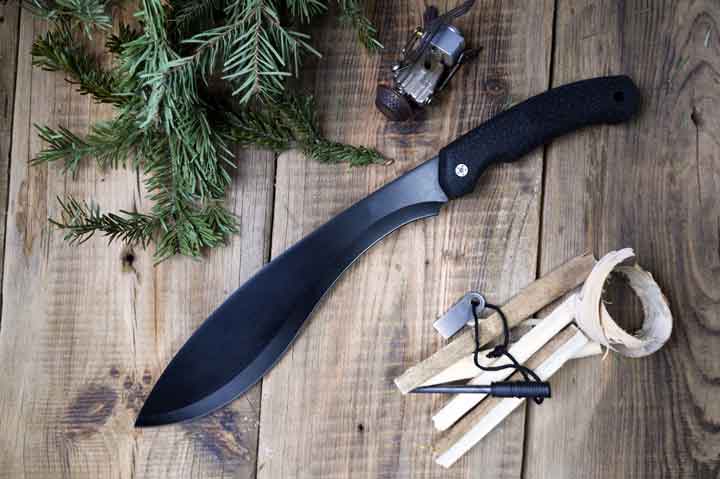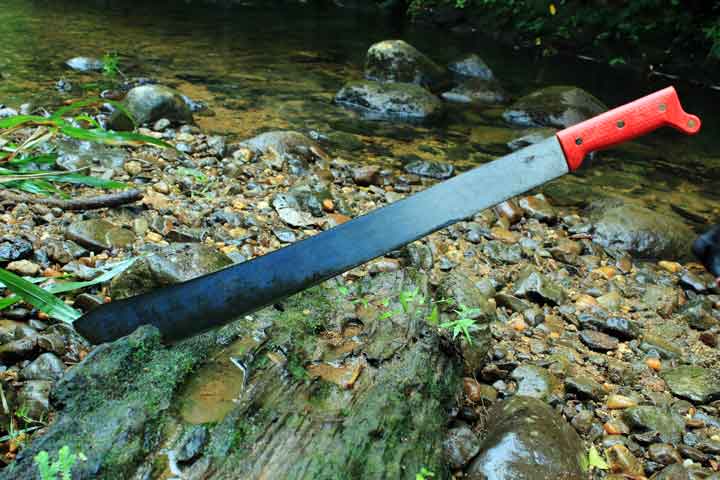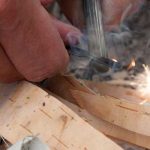As a keen outdoor adventurer, I know that the line between survival and tragedy often depends on whether you have the right gear on hand.
That’s why I dove headfirst into researching all of the machete types available on the market. I never wanted to be caught in the wilderness wielding a barong to chop wood or a billhook to field dress a deer.
A machete can be your ax, knife, and scythe in one lightweight package, as long as you invest in the right blade for the job.
What are Different Machetes Used For?
Any machete is better than no machete in a survival situation, but some blades are best for specific jobs.
Survival and Camping Machetes
You never know what you’ll encounter in the wild, so the best survival and camping machetes are multipurpose and highly durable.
Bowie Machete
Named for famous American pioneer Jim Bowie and made famous by Rambo, this short-bladed weapon is a survivalist’s best friend. Like knives of the same name, this machete makes quick work of skinning game and eliminating dense vegetation.
Kukri Machete
The Nepalese kukri has a unique bend in the center of the blade, which creates a narrow area for carving, a sharp curve for slicing, and a pointed tip for stabbing. While they are traditionally military weapons, many modern frontiersmen appreciate their adaptability as a utility knife.

Heavy Machete
The thick, weighted blade of the heavy machete is an all-purpose tool that can tackle everything from chopping firewood to fending off wild animals. It carries its mass at the front, easily cleaving through hardy vegetation.
Parang Machete
Like the kukri, a parang has three separate sections of blade: the front comes in handy for field dressing, the thicker middle clears brush, and the handle-end is thin enough for carving or shaving.
Brush and Path Clearing Machetes
Trailblazers need a blade that will slice through dense vegetation like a hot knife through butter. Brush and path clearing machetes have a long, weighted edge to power through tangles of underbrush and a comfortable, non-slip handle for safe maneuvering.
Colima Machete
Most machetes only have one honed edge, but the Central American colima boasts two sharpened sides for sweeping through swaths of grass.
Tapanga Machete
The powerful blade of the tapanga lacks the point of most machete types, but it makes up for it with a concentrated chop that virtually melts brush, wood, and shrubbery. You’ll recognize a tapanga because of its flared, straight front, and rugged construction.
Bush Machete
When most folks picture a machete, it’s most likely a bush blade. Also known as the Latin machete, it has a straight back with a gradually curving edge. As the name implies, it makes easy work of beating back brush.

Agricultural Machetes
Since the advent of agriculture, machetes have been favored farming equipment for clearing land, harvesting crops, and butchering livestock.
Billhook Machete
The billhook machete is an ancient agricultural tool with a unique blade that takes a sharp curve at the tip. The design is ideal for stripping branches and pruning woody vines, such as those in vineyards.
Cane Machete
With origins in the sugar cane fields of South and Central America, the cane machete is similar to the tapanga because it sports a broad, blunt tip. In some models, the end has a hook for pulling crops out of the ground.
Self-Defense Machetes
All blades are weapons, but there are some machete types intended explicitly for personal protection.
Bolo Machete
The Philippine bolo machete comes in handy for working narrow fields and opening coconuts, but knife enthusiasts are more familiar with its use in warfare and martial arts. In military slang, “to bolo” means that you’ve failed so spectacularly that it would be better to arm you with a bolo than let you waste ammunition.

Barong Machete
With its leaf-shaped blade and razor-sharp edge, the barong can slice, carve, and scythe. It originated in the Philippines, where farmers use it to cull their livestock efficiently and for personal protection. The barong is a type of bolo.
Golok Machete
Indonesia favors the heavy golok machete for both culinary and combat applications. They have a tapered end with a very slight upturn and a mid-blade center of gravity. Before local authorities outlawed the practice, village strongmen would sport goloks slung on their hips to signify their strength and masculinity.
Frequently Asked Questions
What Type of Blade is a Machete?
A machete is a single-handed broad blade, similar in construction to claymores and sabers.
The broad blade design is better suited for cleaving and chopping rather than stabbing or slicing.
Is a Panga a Machete?
A panga is a machete popular in Africa and the Caribbean, where dense, woody brush makes travel difficult in the forested regions.
It has a rounded “belly” ideal for quickly felling vines, saplings, and other hardy vegetation. The wide berth of the blade provides a good amount of heft on the downswing.
What is a Combat Machete?
A combat machete is any single-edged shortsword intended as a fighting tool rather than an agricultural or survival tool.
During World War I, American foot soldiers armed themselves with bolos against the German troops.
Today, the military still manufactures a standard-issue machete for clearing paths through claustrophobic jungle environments.
Can I Use a Machete to Cut Wood?
You can use some machete types to cut wood, but not all blade designs can stand up to the challenge.
Golok, heavy, and panga machete types are your best bet, thanks to their top-heavy center of gravity.
Can You Split Logs with a Machete?
You can split logs with a machete if you use it as a wedge.
Chop into the log, embedding the machete as deeply as you can.
Then, pound into the exposed end of the blade with a weighted tool, like a rubber mallet or heavy branch, while you use your other hand to guide the edge further into the log.
Some high-quality kukri and heavy machetes can handle log splitting if the blade has enough mass.
What is a Curved Machete Called?
A curved machete is called a kukri or a panga.
Kukris curve forward, centering the majority of its mass at the end. This creates a narrow section near the hilt for carving and a wide belly for chopping.
The panga is straight along most of the blade but takes a sharp curve backward at the front—Panga wielders use this upturned tip for stabbing or piercing.
What Should I Look for in a Machete?
When shopping around for a machete, start by considering its intended purpose.
If you’re planning on clearing your acreage, opt for an agricultural blade that will sweep through grasses and saplings with ease.
Passionate campers typically prefer versatile tools that feature multiple functions along the length of the blade.
Once you’ve narrowed your search, you can get specific about your comfort and design preferences, like blade material and type of handle.
No matter what, ensure that the machete you choose is safe. You can find a high-quality, sturdy tool at every price point, so spend time reading reviews and product specifications.
Conclusion
Machetes have survived the test of time with relatively little change from their ancient origins.
Instead, they have evolved according to local needs, creating an entire family tree of hardy, versatile blades that provide an incredible range of uses from one portable tool.
With so many machete types available, it’s worth your time and energy to test out options until you find the one that feels right. You are the one depending on the blade, so your comfort is crucial.
If you rely on your instincts, keep safety in mind, and always keep a sharpener close at hand, you’ll soon find that your machete is a must-have piece of gear for every excursion you embark on.




